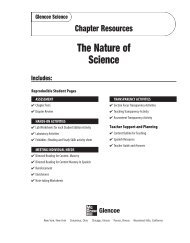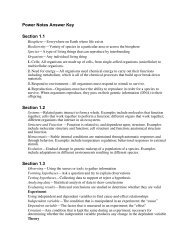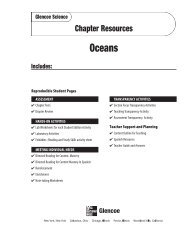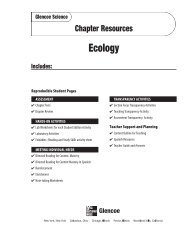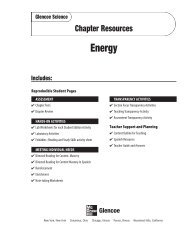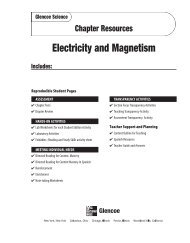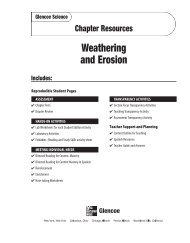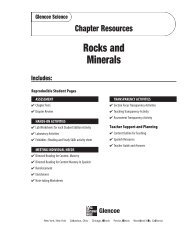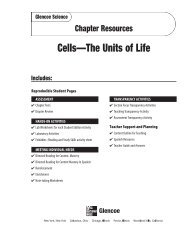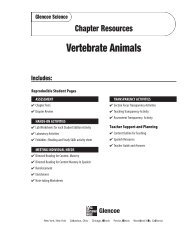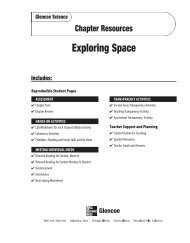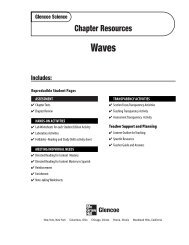Content Outline for Teaching - Potosi School District - Home
Content Outline for Teaching - Potosi School District - Home
Content Outline for Teaching - Potosi School District - Home
Create successful ePaper yourself
Turn your PDF publications into a flip-book with our unique Google optimized e-Paper software.
9<br />
Section 2<br />
<strong>Content</strong> <strong>Outline</strong><br />
<strong>for</strong> <strong>Teaching</strong><br />
Igneous and Sedimentary Rocks<br />
Rocks and Minerals<br />
Underlined words and<br />
phrases are to be filled<br />
in by students on the<br />
Note-taking Worksheet.<br />
A. Igneous rocks—<strong>for</strong>m from melted rock that cools<br />
1. Extrusive igneous rocks <strong>for</strong>m when melted rock cools on Earth’s surface.<br />
2. Intrusive igneous rock <strong>for</strong>ms when melted rock cools beneath Earth’s surface.<br />
3. Light-colored often intrusive igneous rocks containing a high percentage of silica are<br />
called granitic.<br />
4. Dark-colored often extrusive igneous rocks containing iron, magnesium, or calcium<br />
are called basaltic.<br />
5. Lava is melted rock that reaches Earth’s surface and <strong>for</strong>ms extrusive igneous rock<br />
when it cools.<br />
a. Volcanoes can erupt, bringing a lava flow to Earth’s surface.<br />
b. Large cracks or fissures can allow lava to ooze out in a lava flow.<br />
6. Magma is melted rock that does not reach Earth’s surface; intrusive igneous rocks<br />
<strong>for</strong>m as magma slowly cools under the surface.<br />
7. Crystal size is the main difference between intrusive and extrusive igneous rock.<br />
a. Intrusive igneous rocks have large crystals.<br />
b. Extrusive igneous rocks do not have large crystals.<br />
B. Sedimentary rocks <strong>for</strong>m in layers from broken rock, shells, plants, and other materials.<br />
1. Detrital rocks—made of grains from minerals or other rocks that have been compressed<br />
2. Chemical rocks—<strong>for</strong>m when mineral-rich water evaporates and from other chemical<br />
processes<br />
3. Organic rocks—<strong>for</strong>m from dead plants and animals that have been compressed<br />
a. If the rock is produced from layers of plants, it is called coal.<br />
b. If the rock is produced from organic sediment in the ocean, it is usually classified<br />
as limestone.<br />
c. Chalk is a kind of limestone made from the fossils of tiny animals and algae.<br />
Discussion Question<br />
How are lava and magma similar and different? Similar—both melted rock; different—<br />
lava flows to the surface while magma does not reach the surface. Lava <strong>for</strong>ms extrusive<br />
igneous rock, and magma <strong>for</strong>ms intrusive igneous rock with large crystals.<br />
Rocks and Minerals 27




